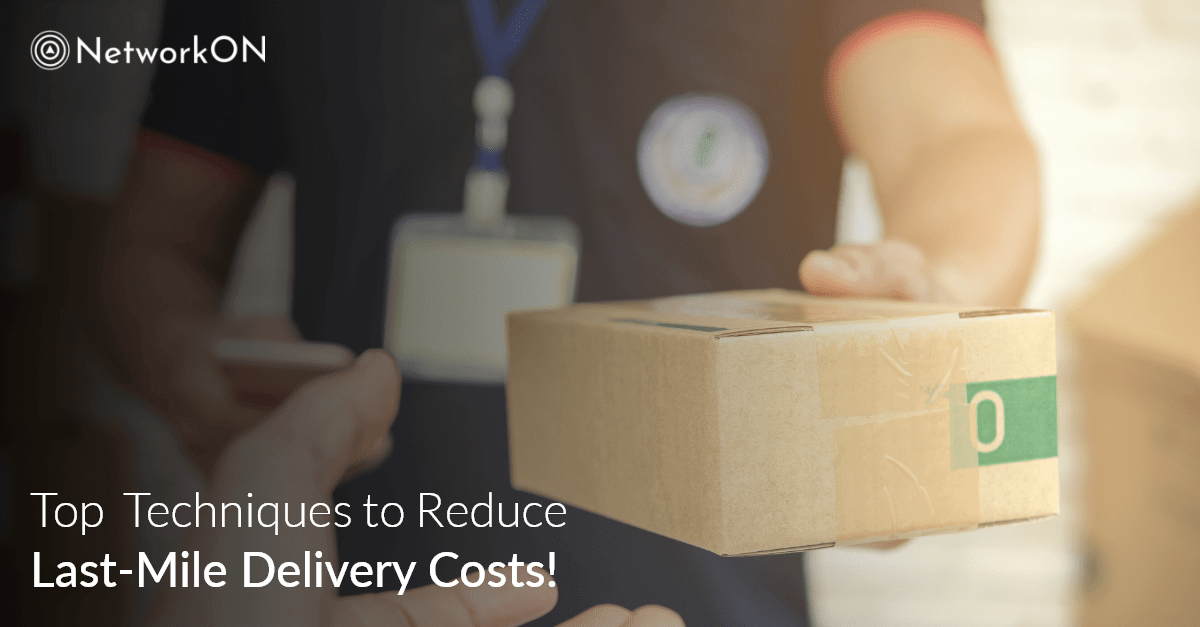Table of Contents
Are your last-mile delivery costs on the rise all the time? It’s unsurprising if you have scaled up in the past few years. While the eCommerce sector has grown substantially during the pandemic, the sudden rush of orders is not the only reason behind increasing last-mile delivery costs.
Changing consumer behavior is another factor behind the increasing costs, and the pressure of delivering delightful customer experiences is taking a toll on businesses worldwide.
There has been a 33% increase in B2B last-mile delivery demand and a 67% increase in B2C businesses over the last two years.
Major delivery companies offer convenient deliveries and enable easy delivery rescheduling or location change, making it difficult to manage last-minute deliveries and keeping costs under control.
Rising costs affect the efficiency of deliveries and that is the reason why 25% of the companies have labeled delivery efficiency as their greatest challenge during the last-mile deliveries.
Major Factors Affecting the Last-Mile Delivery Costs
Before we dive into the details of mitigating the last-mile delivery costs, it is essential to understand the factors that actually drive the costs higher.
1. Shipping Costs:
To cater to consumer demands for flexible delivery, companies have to work constantly to adapt to their surroundings and competitors.
According to a survey conducted among 323 logistics companies, nearly 57% of them shared that their customers demand same-day delivery. It puts an enormous amount of pressure on the delivery fleets and without the right tools or optimized routes, it becomes difficult to keep the costs under control.
It doesn’t end there. There’s more than contributes to the rising costs.
- Nearly 61% customers are likely to cancel their order if they don’t have the option for free shipping
- 93% of overall consumers prefer to shop from a place that offers free delivery
And if one logistics company doesn’t take the orders from these stores, then someone else definitely will, forcing the logistics companies to operate at reduced operating margins.
2. Complexities in Last-Mile Delivery:
Not all places can get access to same-day delivery. In fact, packages change hands at multiple locations before they reach the final delivery point.
And though urban facilities are located close to each other, the faster delivery times can be affected due to traffic congestion and other unseen factors.
So, while the demand for quick deliveries is increasing at a rapid pace, the sheer rush and confusion can add to the complexities of last-mile delivery and increase the amount of money spent on fuel alone.
3. Delivery Failure:
Many logistics companies fail to communicate with their customers on time without a delivery management system. There are instances when a customer cannot know when a package will be delivered.
Such instances fall under failed deliveries and it proves to be a disaster for the logistics company. They spend many hours, fuel, and resources to attempt deliveries only to return it back to base and spend more resources on re-attempting the same delivery the next day.
Top Techniques to Reduce Last-Mile Delivery Costs
Now that you have a clear understanding of the reasons that increase the last-mile delivery costs, it’s time to look at the solutions.
A delivery management system with advanced features is the key to solving this problem. You can streamline your entire delivery process using a robust delivery management solution like NetworkON.
Here are a few ways in which such a solution can optimize your last-mile delivery and make it more cost-efficient.
1. Create Multiple Delivery Options for the Customer:
Truth be told, not all customers look for same-day delivery. Nearly 73% of the customers said that they prefer a package to be delivered at a time of their convenience.
Offering multiple delivery options helps you cut down last-mile delivery costs. How? Let’s understand.
If a customer orders something and their only option is same-day delivery, but they cannot stay at home the whole day, then your delivery attempt is going to fail for sure.
Instead of rushing the order, you can ask the customer the kind of delivery they would like to opt for. You can plan it according to their availability and save money spent on repeat attempts.
2. Automatic Order Assignment:
World’s largest taxi-hailing service Uber operates in many countries and is known for providing taxi services in a matter of minutes. Of course, they use a complex set of algorithms to assign the ride requests automatically but now, you can do it too.
You can automate your delivery job assignment process using a delivery management system. You can use the technology to assign orders automatically based on the delivery executive’s availability in a specific geographical area.
Automated delivery dispatching saves a lot of time that would be spent on manually dispatching each order. Delivery tasks can be assigned automatically and both administrator and delivery teams receive push notifications about the same instantly.
3. Continuous Route Optimization:
Longer distances between the point of origin and destination translate into higher delivery costs.
As a logistics company, you cannot afford to have a scattergun approach to your deliveries. You must constantly optimize your routes and make the entire process as tight as possible.
It is not easy to create multi-stop routes manually. But if you have a delivery management system with AI-powered route optimization capabilities, you can use a variety of data points like traffic, driver capacity, distance, location, and time to create optimized routes.
Also, you can assign new delivery jobs to drivers in specific geolocation and notify them in real-time about the new assignment.
4. Use Digital Proofing to Verify Deliveries
Gone are the days when one had to carry a long list of orders in their bag. These sets of papers were clunky and also prone to damage from rain, theft, and displacement. If you want to save time and money, then switching to a digital proof of delivery is the next step.
First, it cuts down on the cost of paper required to manage all the deliveries, and believe it or not, it is one of the major expenditures for a logistics company.
Second, all the parties involved in the delivery get factual information about each delivery completed. It also eliminates any inconsistencies that can arise when dealing with traditional delivery proofs.
Customers cannot deny receiving a package once it is scanned into the system and the delivery executives can take signatures and photo-proofs on their smart devices without wasting time on paperwork.
5. Keep the Customers Informed at All Times:
Customers always like to know what’s going on with their deliveries. Traditional logistics businesses just inform customers that their order will be delivered on a specific date and leave the customer hanging after that.
In the age of information, you cannot expect the customer to just wait around the whole day waiting for a package and then in many instances, even that delivery is rescheduled for the following day.
Use delivery management software to give customers real-time information about their delivery. Not only does it help them be available at a specific time, but it also adds the overall customer experience
You can also enable direct communication between the customer and the delivery personnel via calls or direct messaging. How is all this profitable for the business?
According to a study, 74% of customers are likely to spend more money with a business if they get a memorable delivery experience. Moreover, 82% of customers are likely to share their positive experiences with their friends and spread positive word of mouth about your business.
6. Use Real-Time Data and Analytics to Make Informed Decisions:
How do you find out about the status of your last-mile deliveries? You analyze data and evaluate your fleet’s performance on different metrics. These include:
- Number of tasks/jobs completed
- Time consumed for each task
- Idle time between deliveries
- Total distance traveled
- Number of failed tasks
NetworkON’s analytics dashboard allows you to view data for every individual or for the whole team. It also generates performance reports for a specific time period.
How do analytics and reporting reduce last-mile delivery costs?
They identify which drivers are performing the best and allows you to find out which routes can be used for faster deliveries. You can also identify the potential traffic points and make better strategies to get optimum performance out of your delivery fleet.
Next Plan of Action
With the aforementioned tips in mind, you can now work on improving the last-mile delivery arm of your logistics business. However, one thing is for certain, you cannot do it without a robust delivery management system.
55% of customers are after faster delivery service and if you fail to deliver in time, they will switch to another brand.
NetworkON is an all-round fleet management system that allows you to optimize your last-mile delivery and improve your services by:
- Improving communication with customers
- Optimizing routes for delivery fleets
- Reducing delivery costs
- Tracking driver activity
- Delivering real-time analytics
Start with NetworkON for free today and get ahead of the competition before they do. For more information and to set up a consultation, email us at info@networkon.io or visit our website today!
Frequently Asked Questions
Q1: Why are last-mile delivery costs increasing, and what factors contribute to this rise?
Last-mile delivery costs are rising due to increased demand for flexible delivery, changing consumer behavior, and the pressure to provide delightful customer experiences. The article highlights a 33% increase in B2B last-mile delivery demand and a 67% increase in B2C businesses over the last two years as contributing factors.
Q2: How do shipping costs impact last-mile delivery expenses, and what challenges do logistics companies face in meeting customer demands for same-day delivery?
Shipping costs play a significant role in last-mile delivery expenses. The article mentions that 57% of logistics companies face customer demands for same-day delivery. Additionally, it explores the challenges companies encounter in adapting to flexible delivery options and the impact on operational costs.
Q3: What complexities are associated with last-mile delivery, and how do they affect the efficiency of the delivery process?
The complexities of last-mile delivery include challenges in reaching all locations with same-day delivery, traffic congestion, and changes in package handling before reaching the final delivery point. These complexities can lead to increased fuel costs and affect the speed of deliveries.
Q4: What role does a delivery management system play in reducing last-mile delivery costs, and how does it address challenges such as failed deliveries?
A delivery management system, like NetworkON, is highlighted as a solution to reduce last-mile delivery costs. It addresses challenges such as failed deliveries by providing real-time communication with customers, automating order assignments, and optimizing routes using AI-powered capabilities.
Q5: How can a delivery management system help create multiple delivery options for customers, and why is this beneficial for reducing last-mile delivery costs?
A delivery management system enables businesses to offer multiple delivery options to customers, allowing them to choose convenient delivery times. This helps cut down last-mile delivery costs by avoiding failed attempts and optimizing delivery schedules based on customer availability.
Q6: How does using real-time data and analytics reduce last-mile delivery costs, and what specific metrics are considered in the analysis?
As provided by NetworkON’s analytics dashboard, real-time data and analytics contribute to reducing last-mile delivery costs by identifying efficient routes, optimizing fleet performance, and analyzing metrics such as completed tasks, time consumption, idle time, total distance traveled, and the number of failed tasks.





0 Conversations